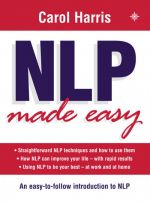Правообладателям!
Представленный фрагмент книги размещен по согласованию с распространителем легального контента ООО "ЛитРес" (не более 20% исходного текста). Если вы считаете, что размещение материала нарушает ваши или чьи-либо права, то сообщите нам об этом.Читателям!
Оплатили, но не знаете что делать дальше?
Текст бизнес-книги "NLP Made Easy"
Автор книги: Carol Harris
Раздел: Жанр неизвестен
Текущая страница: 2 (всего у книги 4 страниц)
Feelings
NLP was largely founded on the activities of therapists and it has continued to emphasize the importance of a balanced emotional state in achieving effective performance. It has techniques for managing emotions, many of them involving the sensory shifts referred to in the previous section. Emotional responses are often brought about by thoughts and are certainly closely linked to them, so by changing thought patterns it is often easy to change emotional responses.
Another way in which NLP engages the emotions is through its association with behaviour. Because there is a close link between body and mind, by making changes in the body, changes in the mind – and thereby the emotions – often follow. An example of this is posture. Most people have habitual postures associated with different emotional states, for example being more upright when energetic and taking up less space when apprehensive. By changing posture it is possible to change the thoughts and feelings which follow. So, to get someone to feel more energetic, it is possible to identify their personal posture for energy and then help them re-create it; once they have done so, they are more likely to feel energetic. The same goes for states such as calmness, relaxation, motivation, enthusiasm and so forth – certain postures are more likely to produce each of these states in a given person.
Beliefs
One of NLP’s strengths is its ability to influence change at deep levels. Although change can be brought about by teaching people new skills, it is beliefs, values and assumptions which are the foundation of each individual.
Much of NLP is about changes in beliefs, values and attitudes, sometimes direct and sometimes indirect. For example, a direct belief change could be brought about by confronting a person with an example which contradicts their previous experience; maybe showing them a yellow tomato if they believed tomatoes were always red or encouraging a person from a minority group to apply for (and get) a senior job which they had believed was beyond their reach. An indirect belief change could be brought about through exposing a person to different learning situations which, cumulatively, resulted in them changing their beliefs, for example giving a person who believed they were poor at public speaking the opportunity to practise until they were convinced they could do it. Equally, assumptions may be changed when a person gains a different perspective on a situation, for example a person who thinks a neighbour is being indifferent to them, but then finds out the person is hard of hearing and has not been able to hear what is being said.
The interesting thing about the way in which NLP works to effect such changes is that it can help people experience changes in their mind, rather than having to put them in ‘real-life’ situations to face real (or imagined) obstacles. It has been found that people have actual mental ‘locations’ for beliefs and that by helping a person to locate and utilize these locations, it is possible to influence the strength of their beliefs.
Spirituality
NLP also offers ways of exploring what is ‘beyond’ everyday experience. Spirituality is a rather different concept from the other elements I have been discussing, ie behaviour, thoughts, feelings and beliefs. These elements are easier to communicate, as people are likely to have more of a shared understanding of them. For example, in discussing behaviour, it is relatively easy to discuss whether a shop assistant has been helpful or uninterested, or whether a student is listening or distracted; these things are relatively easy to observe and construe. With spirituality, however, each person’s experience is both ‘internal’ and personal and the vocabulary with which to discuss it is frequently more limited.
For example, two people may visit an area of countryside where they can enjoy seeing the landscape, hearing the sounds of animals, feeling the sunshine and being aware of the scents in the air. One person may simply experience this as a pleasant day out; for the other person the outing may provide an awareness of something beyond the immediate experience, perhaps a sense of fulfilment, of integration, or of a power or quality which permeates the senses. While being acutely conscious of this personal experience, it may be difficult for the second person to explain in everyday language what their awareness actually is.
Despite these limitations, many people working with NLP are helping others to develop their spiritual sense and awareness.
Features of NLP
NLP has some specific features which mark it out; other disciplines may have one or more of these, but the combination of all makes NLP distinctive. What are these features?
It takes a holistic approach
NLP takes the view that all parts of a person are interrelated and that changes in one part impinge or reflect on all the others. This approach ensures that the overall consequences of any change process is considered.
It works with micro-details
In contrast to being holistic, NLP is also often concerned with minute detail. An example of this is the way in which it works with specific elements of thought processes, such as how people visualize and how they use ‘internal dialogue’. NLP enables people to analyse such processes in a way that helps them be more effective. Working with detail often helps understanding and assimilation and makes it possible to work on one element at a time, rather than being swamped by multiple activities.
It is based on competency and role modelling
NLP is very much to do with individual skills and abilities. In this respect it ties in well with current approaches to training and development. The foundation of NLP is ‘modelling’ (see Chapter 3), especially ‘role modelling’ effective people, finding out precisely which elements of their performance are contributing to their success, and then helping others to perform in a similar manner.
It focuses on mental processing
Although a good deal of NLP is about behaviour, much of it is about how people’s thoughts influence their performance. NLP offers ways of modifying mental patterns (or strategies) and helping people make changes in these to help enhance their lives.
It utilizes specific language patterns
Utilization of language patterns provides powerful techniques for interacting with others and bringing about change. NLP has a wide range of language processes and patterns that can be applied in a variety of contexts.
It works with both the conscious and the unconscious mind
The terms ‘conscious’ and ‘unconscious’ have been used in various parts of this book. The state of consciousness is generally recognizable as an awareness of oneself or elements in one’s environment (or beyond).
The term ‘unconscious’ is commonly applied to states such as sleep, anaesthesia or fainting, but can also be used to describe mental processes that are ‘out of awareness’. These ‘out-of-awareness’ processes can include a wide range of things; for example having a mannerism of which one is not consciously aware, becoming familiar with a language simply by being exposed to hearing it rather than consciously taking time to learn the words or grammar, or responding to something in an automatic way without being aware of why that is happening (for example considering a person attractive because the pupils of their eyes are dilated, but not being aware that that fact is influencing your reaction).
Although there are differing views on how, or whether, unconscious processes actually exist (they could simply be pre-programmed behaviour rather than evidence of an ‘unconscious’ part of the mind), there is a general acceptance that the unconscious mind does exist and has a powerful influence on our attitudes and behaviour. This influence may be either positive or negative, resulting in behaviour which either achieves beneficial results or hinders them. The recognition of the influence of the unconscious mind informs much of NLP’s work, so that, although it is possible to use NLP to work solely at a conscious level, for example to break down a skill into concrete parts in order to teach it, it is probably most effective when it integrates conscious/unconscious processing. For example, when teaching a skill to people who believe that they will find it hard to learn, it is possible to manage the process of teaching so that it incorporates elements which reach the unconscious mind and are directly absorbed by the learner at a deep level.
A note of caution should be added here. Because some techniques appear to work directly at an unconscious level, bypassing conscious awareness, they could be open to misuse or could inadvertently cause undesirable results. Such techniques should therefore only be used after sufficient training and with the safeguards of respect and concern for the person who is ‘on the receiving end’. For this reason, certain techniques have only been described in outline in this book, so that they will not be practised without sufficient guidance and skill.
It is rapid in its processes and results
A major feature of NLP is the speed with which it can produce results. Many NLP techniques are extremely rapid in their application (the most famous probably being the ‘fast phobia cure’, which can successfully be carried out in a matter of minutes). Because of the speed of such processes, many people do not believe they can really work and are therefore sceptical about NLP as a whole. Current thinking, however, is that the brain works (and learns) speedily and therefore change can be brought about rapidly. This is in contradiction to many traditional approaches, especially that of psychoanalysis, which maintain that lengthy courses of treatment – often running into years – and taking people back into the past, instead of having the future focus that is characteristic of NLP, are necessary to bring about insight and change.
It is neutral as an approach
NLP as an approach is neutral. It is a tool, not a prescription. How NLP is used depends entirely on the practitioner and the user/client. There are as many ways of using NLP as there are people working with it.
It is respectful in how it treats people
An interesting thing about NLP is that one of its principles involves respect for others; its importance is instilled from the early stages in training. Because of this, attention is paid to what is termed ‘ecology’, which in NLP means the circumstances surrounding any particular intervention. To be ecological means considering the broader context of an intervention, paying attention to the needs and wishes of the person/s with whom you are working, taking into account their point of view as well as your own beliefs about what is desirable. This emphasis on ethics makes NLP stand out from many other disciplines.
Presuppositions
Another feature of NLP is its ‘presuppositions’. These are statements which are not necessarily held to be ‘true’, but used as assumptions which influence strongly the behaviour and responses of those using NLP. Here are some of NLP’s commonest presuppositions:
Experience has structure
There are patterns to how we think about/organize our experience, and if we change these patterns, our experience changes with it.
A map is not the territory
People’s perceptions are subjective; what you perceive is selective, not a complete, or necessarily true, account of reality. So, for example, a colour-blind person would not perceive certain distinctions in colour, but this does not mean they do not exist. Similarly, a person might construe another’s behaviour as malevolent, but this might not be the case. We see and respond according to our own selectively filtered ‘maps of the world’ and helping people understand theirs, and acknowledge those of others, is a feature of NLP.
The mind and body are one system
What we do with our minds and our bodies is interlinked. For example, sitting in a particular posture can lead us to feel a particular emotion; similarly, a positive thought will have an effect on our physiology. There is currently much emphasis on the interrelation of mind and body on health (for example the use of visualization in helping fight cancer) and the field of PNI (psychoneuroimmunology) is demonstrating such links on an ongoing basis.
People work perfectly
Instead of thinking of people as faulty because they do not do what seems to be appropriate, conventional or effective, it is useful to think of them as being extremely effective at getting particular results, even though these results may not be the ‘best’ in the circumstances. So, for example, someone who has a phobia, say of spiders, is excellent at maintaining a frightened response; this may be inappropriate for house spiders, but could be a real help in keeping away from poisonous spiders in a tropical country.
If something is possible for one person it is possible for everybody
This does not mean that everyone can be an Olympic athlete, brain surgeon or artist; it simply means that if something can be done by one person, then potentially everyone could do it, given suitable resources. This presupposition is helpful in encouraging people to extend their performance beyond what they might previously have believed possible.
Everyone has all the resources they need
People have within themselves a vast reservoir of ‘internal’ abilities and attributes; achievement is generally more about what you bring to a situation than external elements.
There is no failure, only feedback
If you do not achieve what you set out to, this can be taken as useful information to help you in your future endeavours, rather than as evidence that you are incapable of achieving what you desire.
If what you are doing isn’t working, do something else
Flexibility is a key to effectiveness; if you vary what you do until you get a result, you are more likely to be effective than if you continue to carry out behaviour which is not getting you to where you want to be.
You do the best you can at the time
Although, with hindsight, many things could be done differently, we can only make the best choice at the time. This does not mean that we always make the ‘right’ decision; simply that decisions are based on ‘best guesses’ at the time. (‘New code’ NLP might take a different view of this and help us listen more to our ‘body signals’, but more of that in Chapter 3.)
Every behaviour has a positive intent
Even the most negative-seeming behaviour is done for a purpose. This is a useful assumption to make when dealing with others, as it enables you to consider why they behave as they do, to explore their real needs and, possibly, to find alternative ways of meeting them.
The meaning of the communication is the response you get
It is the perception of the receiver that determines the effectiveness of interaction, not the intention of the initiator.
Almost all the presuppositions have been debated at length, for example the proposal that all behaviour has a positive intent, or the fact that what is possible for one person is potentially possible for all. However, the point of the presuppositions is to enable people to extend themselves and to perceive opportunities and benefits in situations. By acting as if the presuppositions were true, it is amazing what can be achieved.
Associations
Where did NLP come from? Many of the ideas used in NLP originated in much earlier times. Certainly many of the concepts were known about decades ago and some were mentioned, although in very different terminology, centuries ago. There are, however, a number of specific connections between NLP and other established disciplines, in particular the following:
 Applied psychology: It is easy to think of NLP as a branch of applied psychology. To label it in this way is really to diminish its impact, as it goes beyond the bounds of traditional psychology, but it is probably a good initial way of considering it. One explanation of how NLP goes beyond conventional psychology is as follows: ‘While traditional clinical psychology is primarily concerned with describing difficulties, categorizing them, and searching for historical causes, NLP is interested in how our thoughts, actions, and feelings work together right now to produce our experience.’ (Faulkner) There is also a link with psychometric testing (and some Jungian ‘traits’) in the use of one of the NLP language patterns called Meta-Programmes (see Chapter 5).
Applied psychology: It is easy to think of NLP as a branch of applied psychology. To label it in this way is really to diminish its impact, as it goes beyond the bounds of traditional psychology, but it is probably a good initial way of considering it. One explanation of how NLP goes beyond conventional psychology is as follows: ‘While traditional clinical psychology is primarily concerned with describing difficulties, categorizing them, and searching for historical causes, NLP is interested in how our thoughts, actions, and feelings work together right now to produce our experience.’ (Faulkner) There is also a link with psychometric testing (and some Jungian ‘traits’) in the use of one of the NLP language patterns called Meta-Programmes (see Chapter 5).
 Gestalt psychology/psychotherapy: One of the early role models for NLP was Fritz Perls, the reputed father of Gestalt psychotherapy. Gestalt relates to the linkages between elements, so that an entity can be understood through the interrelationships of its parts; the parts alone do not necessarily make sense. (One area of NLP deals with ‘parts’ and that will be covered in more detail in Chapter 3.)
Gestalt psychology/psychotherapy: One of the early role models for NLP was Fritz Perls, the reputed father of Gestalt psychotherapy. Gestalt relates to the linkages between elements, so that an entity can be understood through the interrelationships of its parts; the parts alone do not necessarily make sense. (One area of NLP deals with ‘parts’ and that will be covered in more detail in Chapter 3.)
 Ericksonian hypnosis: Another early role model was Milton Erickson and his influence on NLP has been enormous. Unlike classical hypnosis, the Ericksonian approach is seemingly low key and unobtrusive. Much use is made of indirect language, suggestion and utilization of the patient/client/subject’s own patterns of speaking, breathing and moving in order to bring about change. Erickson himself was expert at adapting his approach to the specific needs of the individual with whom he was working and this way of working has informed many of NLP’s later practitioners (although the indirect approach is closely linked with Erickson, he was substantially influenced by classical hypnosis and did use a lot of direct techniques himself).
Ericksonian hypnosis: Another early role model was Milton Erickson and his influence on NLP has been enormous. Unlike classical hypnosis, the Ericksonian approach is seemingly low key and unobtrusive. Much use is made of indirect language, suggestion and utilization of the patient/client/subject’s own patterns of speaking, breathing and moving in order to bring about change. Erickson himself was expert at adapting his approach to the specific needs of the individual with whom he was working and this way of working has informed many of NLP’s later practitioners (although the indirect approach is closely linked with Erickson, he was substantially influenced by classical hypnosis and did use a lot of direct techniques himself).
 Systems thinking/cybernetics: Much of NLP utilizes systems thinking. Work by Ashby, Beer and others has had a major impact on how NLP has developed and been used and many of the NLP models presented in Chapter 3 explore the systemic nature of different areas of experience.
Systems thinking/cybernetics: Much of NLP utilizes systems thinking. Work by Ashby, Beer and others has had a major impact on how NLP has developed and been used and many of the NLP models presented in Chapter 3 explore the systemic nature of different areas of experience.
 Linguistics: Much of NLP originated in the work of linguists, including Korzybski and Chomsky. Such people had laid down many of the principles which underlie NLP’s language patterns. Some of the connections which have been made are with the ways in which language represents experience, especially in a metaphorical sense, and the ways in which language demonstrates people’s underlying motivational and Behavioural patterns.
Linguistics: Much of NLP originated in the work of linguists, including Korzybski and Chomsky. Such people had laid down many of the principles which underlie NLP’s language patterns. Some of the connections which have been made are with the ways in which language represents experience, especially in a metaphorical sense, and the ways in which language demonstrates people’s underlying motivational and Behavioural patterns.
In addition, some topics that are becoming associated with NLP are:
 Accelerated learning: Accelerated learning puts much emphasis on the needs of the individual and the helpfulness of recognizing and utilizing individual patterns in order to enhance learning and development. The earliest writer on this topic was the Bulgarian Georgi Lozanov, working in the 1960s, and other famous names in the field are Ostrander, Schroeder and Jenson, who have written at length about how to improve trainer/trainee relationships. In particular, accelerated learning puts the onus on the trainer to ensure that the learner is in a resourceful state in which to learn, and this means that learning is not simply a one-way process of pushing information towards a recipient and hoping it will stick, but involves creating an atmosphere and an environment in which interaction and mutual respect can lead to individual growth.
Accelerated learning: Accelerated learning puts much emphasis on the needs of the individual and the helpfulness of recognizing and utilizing individual patterns in order to enhance learning and development. The earliest writer on this topic was the Bulgarian Georgi Lozanov, working in the 1960s, and other famous names in the field are Ostrander, Schroeder and Jenson, who have written at length about how to improve trainer/trainee relationships. In particular, accelerated learning puts the onus on the trainer to ensure that the learner is in a resourceful state in which to learn, and this means that learning is not simply a one-way process of pushing information towards a recipient and hoping it will stick, but involves creating an atmosphere and an environment in which interaction and mutual respect can lead to individual growth.
 Bodywork: NLP is increasingly being associated with the field of physical development as well as psychological enhancement. Some examples of current links are the Alexander Technique, Feldenkrais, kinesiology, tai chi, voicework/singing, and so forth. With all of these techniques, practitioners use a mixture of body movement and mental/emotional control to achieve results.
Bodywork: NLP is increasingly being associated with the field of physical development as well as psychological enhancement. Some examples of current links are the Alexander Technique, Feldenkrais, kinesiology, tai chi, voicework/singing, and so forth. With all of these techniques, practitioners use a mixture of body movement and mental/emotional control to achieve results.
NLP constantly draws upon other disciplines and approaches to integrate appropriate parts of them with its own ways of working. Because of this, NLP is evolving all the time and, while it remains recognizable, is fluid and flexible.
Misconceptions
Having explained what NLP is, it is also important to mention what NLP is not. There are several popular misconceptions about NLP and the following questions are often asked by people new to NLP:
Правообладателям!
Представленный фрагмент книги размещен по согласованию с распространителем легального контента ООО "ЛитРес" (не более 20% исходного текста). Если вы считаете, что размещение материала нарушает ваши или чьи-либо права, то сообщите нам об этом.Читателям!
Оплатили, но не знаете что делать дальше?







